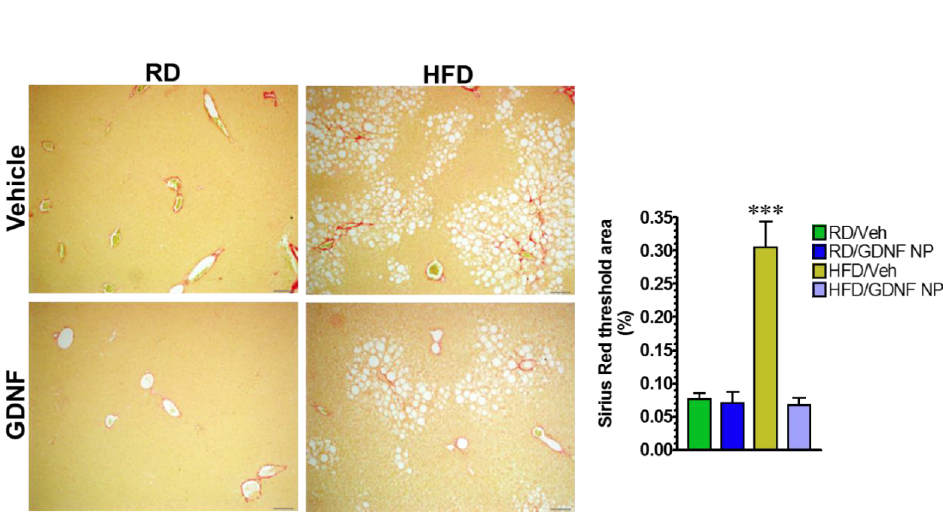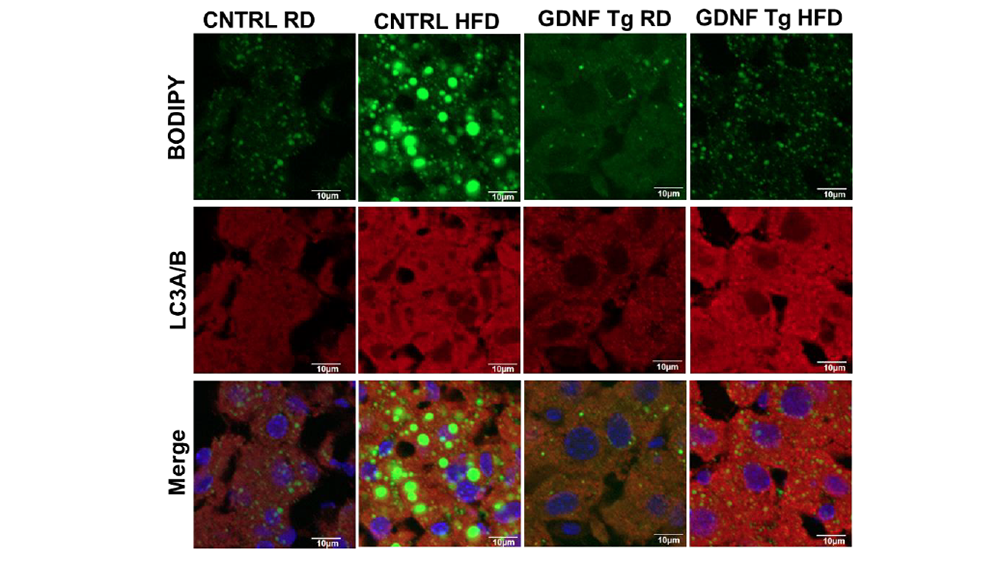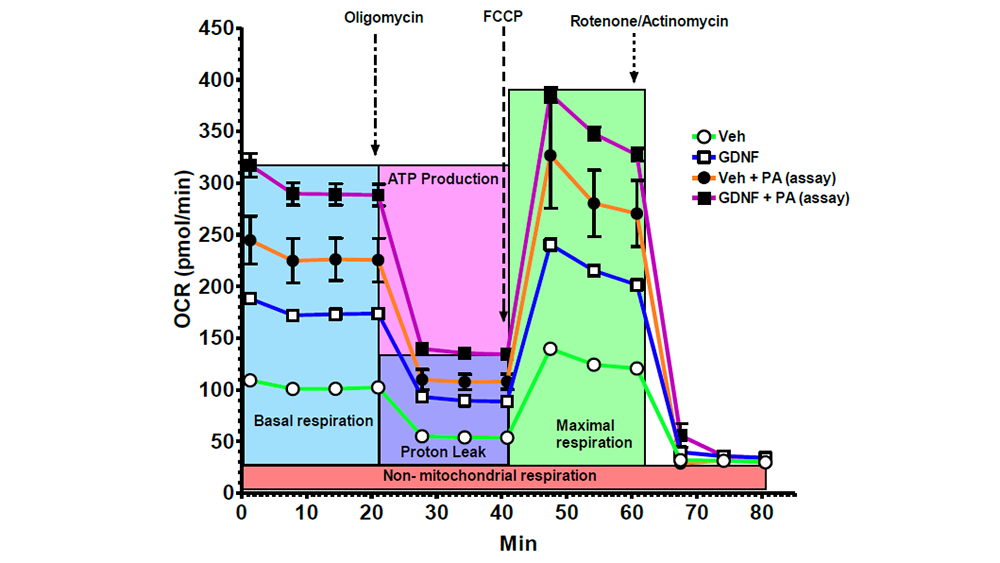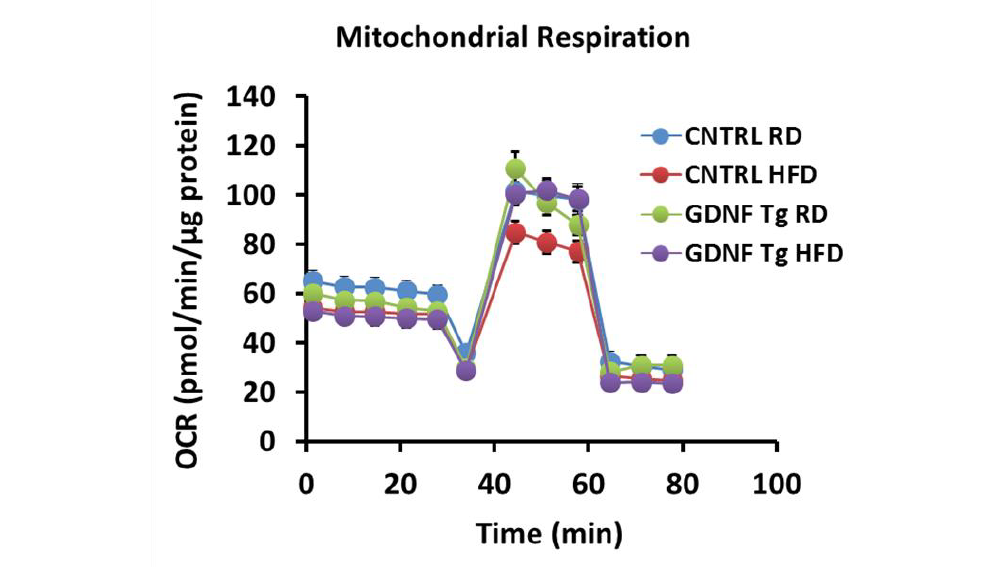Introduction of Research
Non-alcoholic fatty liver disease (NAFLD) is a common cause of chronic liver disease in the US population and its prevalence continues to increase with the growing obesity epidemic. In 2015-2016, it was estimated that 39.8% of US adults and 18.5% of the youth were either obese (CDC). In 2008, complications arising from obesity and its related metabolic syndrome cost the US health care system $147 billion (CDC MMWR report, August 2010). Currently there are no FDA approved drugs for the treatment of hepatic steatosis. Strategies to prevent and treat obesity can reduce obesity related complications (like NAFLD) and lower healthcare costs.
Our previous studies have shown that glial cell line derived neurotrophic factor (GDNF), a factor required for the survival of sympathetic, catecholaminergic and enteric neurons, is protective against high fat diet (HFD)-induced obesity and hepatic steatosis (fatty liver) in mice. The mechanisms by which GDNF protects against diet-induced obesity and hepatic steatosis, have, however, not been fully investigated.
The aim of this project is, therefore, to understand how GDNF protects against diet-induced fatty liver disease and to test if GDNF or it agonist can be used therapeutically to treat or prevent NAFLD.
The project’s main focus is on the role of GDNF in enhancing hepatocyte:
- Autophagy (specifically, lipophagy);
- mitochondrial respiration; and
- fatty acid β-oxidation;
and in preventing diet-induced
- hepatic de novo lipogenesis; and
- hepatocyte death through apoptosis and pyroptosis.
Stream of Research

GDNF transgenic mice are protected against high fat diet-induced hepatic steatosis. Oil Red O-stained liver sections from 12 weeks regular diet (RD) and high fat diet (HFD) -fed control (CNTRL) and GDNF transgenic (GDNF Tg) mice.

GDNF loaded nanoparticles protect mice with longstanding hepatic steatosis against liver fibrosis. Sirius Red-stained liver sections from mice fed a regular diet (RD) or high fat diet (HFD) for 19 weeks and during the last 13 weeks administered vehicle or GDNF-loaded nanoparticles.

GDNF enhances lipophagy in mice liver. Staining for lipid droplets (BODIPY) and the autophagy protein LC3 in liver from regular diet (RD) and high fat diet (HFD)-fed control (CNTRL) and GDNF transgenic (GDNF Tg) mice.

GDNF enhances fatty acid β-oxidation in hepatocytes. Mitochondrial respiration in HepG2 cells exposed to glial cell line derived neurotrophic factor (GDNF) and palmitate (PA).

GDNF transgenic mice are protected against high fat diet (HFD)-induced suppression of hepatocyte mitochondrial respiration. Mitochondrial respiration in hepatocytes isolated from liver from regular diet (RD) and high fat diet (HFD)-fed control (CNTRL) and GDNF transgenic (GDNF Tg) mice.
Associated Publications
1. Mwangi SM, Li G, Ye L, Liu Y, Reichardt F, Yeligar SM, Hart CM, Czaja MJ, Srinivasan S. Glial Cell Line-Derived Neurotrophic Factor Enhances Autophagic Flux in Mouse and Rat Hepatocytes and Protects Against Palmitate Lipotoxicity. Hepatology. 2019 Feb 4. doi: 10.1002/hep.30541. [Epub ahead of print].
2. Mwangi SM, Peng S, Nezami BG, Thorn N, Farris AB 3rd, Jain S, Laroui H, Merlin D, Anania F, Srinivasan S. Glial cell line-derived neurotrophic factor protects against high-fat diet-induced hepatic steatosis by suppressing hepatic PPAR-γ expression. Am J Physiol Gastrointest Liver Physiol. 2016 Jan 15; 310 (2):G103-16.
3. Mwangi SM, Nezami BG, Obukwelu B, Anitha M, Marri S, Fu P, Epperson MF, Le NA, Shanmugam M, Sitaraman SV, Tseng YH, Anania FA, Srinivasan S. Glial cell line-derived neurotrophic factor protects against high-fat diet-induced obesity. Am J Physiol Gastrointest Liver Physiol. 2014 Mar; 306(6):G515-25.
4. Mwangi S, Anitha M, Mallikarjun C, Ding X, Hara M, Parsadanian A, Larsen CP, Thule P, Sitaraman SV, Anania F, Srinivasan S. Glial cell line-derived neurotrophic factor increases beta-cell mass and improves glucose tolerance. Gastroenterology. 2008 Mar; 134(3):727-37.

